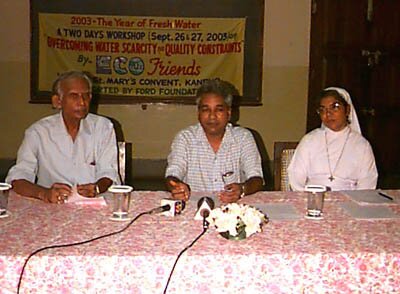 |
|||
|
|||
 Access to enough water of sufficient quality is fundamental for all human, animal and plant life as for most economic activity. At the global level, plenty of water is available. But to meet the demand, water has to be supplied where and when it is needed. The problem is mismanagement of water resources. Water sources are being exploited injudiciously and the same is being polluted mindlessly. There is no easy solution to water related problems. Increases in water supplies are needed, but so is demand management. Access to enough water of sufficient quality is fundamental for all human, animal and plant life as for most economic activity. At the global level, plenty of water is available. But to meet the demand, water has to be supplied where and when it is needed. The problem is mismanagement of water resources. Water sources are being exploited injudiciously and the same is being polluted mindlessly. There is no easy solution to water related problems. Increases in water supplies are needed, but so is demand management.
Irrigation accounts for around 70% of water withdrawals worldwide and over 90% in developing countries. Water constraints may make expanding irrigation to feed additional 1.5 billion people by 2025 impossible. Access to clean water for drinking, cooking, bathing and other household needs is fundamental, but over 1 billion people lack safe domestic water supplies. More than 335 million of world’s population lives in water stressed or water scarce countries. With present consumption patterns two out of every three persons on the earth will live in water stressed conditions by 2025. Water pollution adds enormously to existing problems of water scarcity. The pollution threat is particularly serious when it affects groundwater supplies, where contamination is slow to dilute and purification measures are costly. Annual precipitation volume (including snowfall) in India is 4,000 cu km and annual potential flow in rivers is 1,869 cu km. But the utilizable surface water resources are just 690 cu km and ground water resources 432 cu km only. In the five decades since independence, India has witnessed phenomenal development of water resources. Infrastructure for safe drinking water has been provided to about 85% of India’s population. However, there remain significant challenges in providing water to all sustain ably. From 1951 to 1997, gross irrigated areas expanded four-fold, from 23 million ha to 90 million ha. However, this achievement has been at the cost of ground water depletion, waterlogging and increasing salinity levels. With the rapid population growth since independence, water is becoming an increasingly scarce resource in the country. Despite this, water continues to be used inefficiently on a daily basis in all sectors. At independence, the population was less than 400 million and per capita water availability over 5000 cu m per year. Today, 56 years later, the population has grown to more than 1 billion and water availability has fallen to 2000 cu m per capita per year. The situation is already critical at river basin and local levels: 6 of India’s twenty major river basin have a water availability of less than 1000 cu m per capita per year. India’s finite and fragile water resources are stressed and depleting, while sect oral demands (including drinking water, industry, agriculture and others) are growing rapidly in line with urbanization, population increases, rising incomes and industrial growth. Almost all the major rivers and streams in UP are highly polluted. There are around 6,200 habitations in the state with no safe ground water sources for drinking. Unnao has 30% habitation with no safe source, followed by Jhansi (17%), Ghaziabad(13.7%), Meerut(12.7%), Mathura(11.2%) and Ferozabad(10.3%). Unsafe water is impacting peoples’ health very badly. The total number of Disability Adjusted Life Years (DALY) – a measure of human power wasted due to illness- attributable to water pollution in UP has been calculated as 6.4 million per year. The monetary value of this number of DALYs is around 10,000 crore rupees. Some parts of UP are affected by acute water scarcity with 30% of habitations receiving water less than 40 LCPD, the number of villages that are short of water soared from 17,000 to 70,000 in the last two decades. Of the 1,12,566 villages, about 12% are still not covered with any form of water supply and 38% are only partially covered. The situation in the urban areas is not much different. 53% of towns meet less than half of the standard water supply in the state. To provide water supply as per the norms, Rs. 8,209 crore would be required. But the funds sanctioned annually for the water sector in UP have never exceeded Rs 200 crore. In nutshell, the scenario is very scary. Life cannot be imagined without water. Three-forth of our body is water. Scarcity and the degraded quality of water have endangered our life. We intend to educate and make people aware about the importance of water in our life and need to protect this precious resource. Do strengthen our efforts and make our endeavor meaningful. |
|||
|
|
|||
|
|
|||
|
About Us | About Kanpur | About Ganga | GAP | Activities | Accomplishment | Projects | Eco Talk | Reports | Contact | Support Us |
|||
|